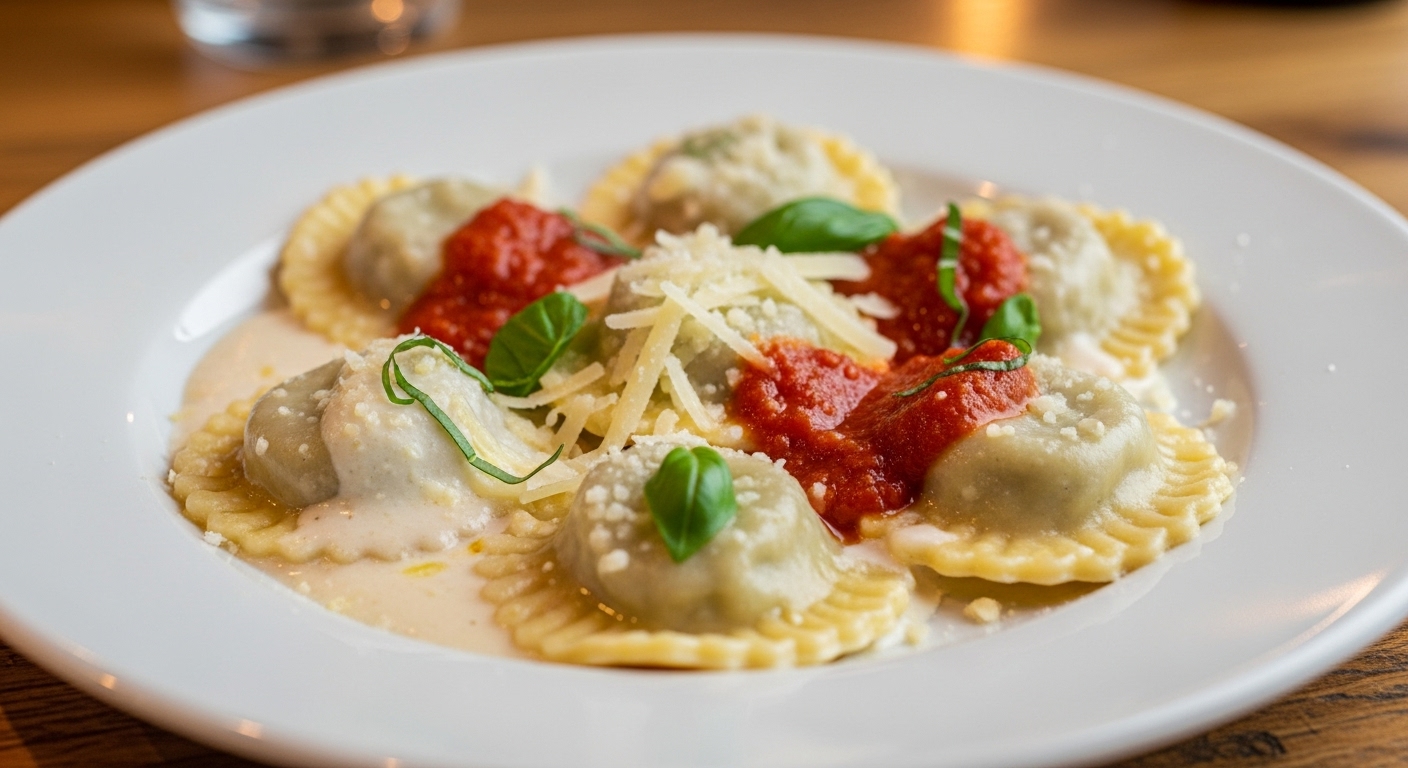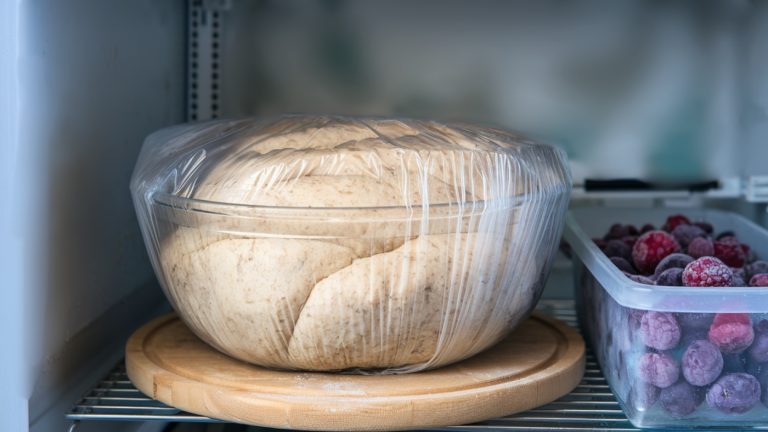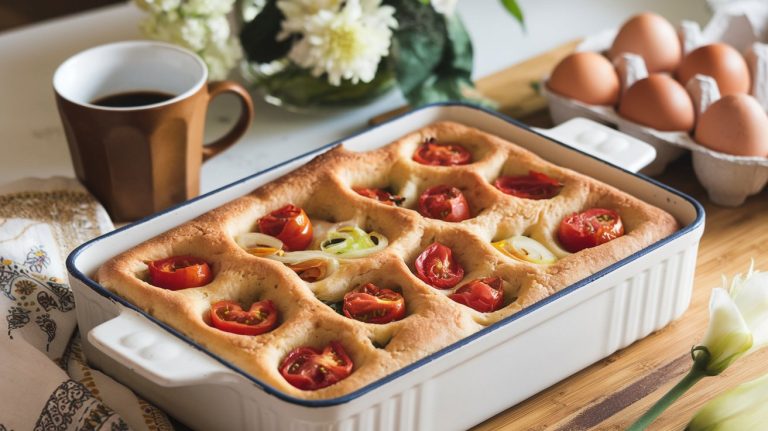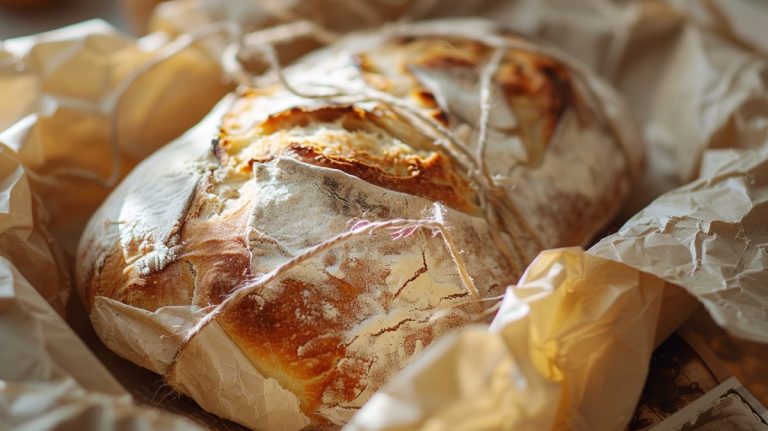Sourdough Ravioli Recipe: A Tangy Twist on Classic Pasta
To make sourdough ravioli, combine 300–400 grams of flour with 125–150 grams of active sourdough starter, eggs, and a pinch of salt.
Knead the dough until smooth, then let it rest for at least 30 minutes.
Fill with your choice of ricotta, vegetables, or meat, and assemble by sealing the edges.
Cook in boiling salted water for 4–6 minutes, and you’re ready to savor an extraordinary dish.
Stick around to discover tips for perfecting your ravioli experience.
Key Takeaways
- Combine 300-400 grams of flour, 125-150 grams of sourdough starter, 2 eggs, and a pinch of salt to create the dough.
- Knead the dough for 5-10 minutes until smooth, then rest for at least 30 minutes to relax gluten.
- Roll the rested dough into thin sheets, then spoon your desired filling onto the sheets, spacing them evenly.
- Moisten the edges of the dough with water, seal tightly, and crimp with a fork to prevent air pockets.
- Cook ravioli in boiling salted water for 4-6 minutes until they float, then serve with your favorite sauce.
Delicious Sourdough Ravioli Recipe at a Glance
| Ingredient / Step | Measurement / Time | Purpose / Notes |
|---|---|---|
| Flour (Tipo 00 or All-Purpose) | 300–400 g | Base structure of the dough |
| Active Sourdough Starter | 125–150 g | Adds tangy flavor & elasticity |
| Eggs | 2 large (plus optional yolk) | Richness, color, and binding |
| Salt | Pinch (about ½ tsp) | Enhances overall flavor |
| Olive Oil (optional) | 1 tbsp | Adds suppleness & smooth texture |
| Semolina Flour | For dusting | Prevents sticking during rolling |
| Resting the Dough | 30 min–24 hrs | Develops gluten, improves texture |
| Filling Choices | Cheese, vegetables, meats, seafood | Customize flavor combinations |
| Cooking Time | 4–6 minutes in salted boiling water | Ravioli float when ready |
| Serving Suggestions | Marinara, creamy sauces, parmesan | Complements tangy sourdough taste |
Ingredients for Sourdough Ravioli Dough
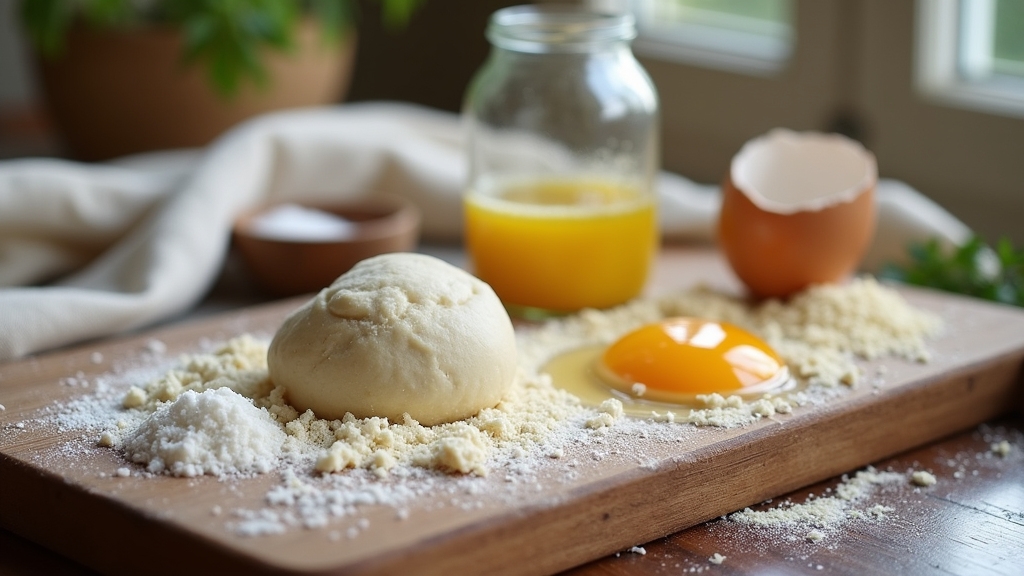
When you’re ready to make delicious sourdough ravioli, gathering the right ingredients is essential for achieving that perfect texture and flavor.
Start with about 300–400 grams of flour; all-purpose flour is great for structure, but consider using tipo 00 for a silky finish.
Add 125 to 150 grams of active sourdough starter for that mild tang and flexibility. Two large eggs enrich the dough, enhancing elasticity and color.
If you want a richer taste, include an extra yolk. Don’t forget a pinch of salt to boost flavor!
Using all-purpose flour provides structure and ease of rolling, making it an ideal choice for your dough.
Use semolina flour for dusting to prevent sticking, and reserve some extra flour for managing stickiness during rolling.
Making the Dough and Preparation Steps
To get started on your sourdough ravioli, you’ll need the right ingredients and precise measurements. Mixing and kneading the dough properly is key to achieving that perfect texture, so don’t skip those techniques. Once you’ve kneaded it to a smooth consistency, allowing the dough to rest will unseal its full potential.
This resting period makes it easier to roll out later, and using a sourdough base can enhance the flavor and texture of your ravioli dough.
Ingredients and Measurements
Crafting the perfect sourdough ravioli dough starts with a balanced blend of ingredients that enhance both flavor and texture. You’ll need about 300 grams of flour, ideally a mix of all-purpose and whole grain Kamut for complexity.
Incorporate 125 to 150 grams of sourdough starter and 2 to 4 eggs, depending on your recipe size. This homemade pasta dough can be further enhanced with therapeutic and rewarding practices that allow you to refine your skills over time.
Don’t forget to add ½ teaspoon of sea salt for flavor enhancement and optionally, 1 tablespoon of olive oil for suppleness.
| Ingredient | Measurement | Purpose |
|---|---|---|
| Flour | 300 g | Base of the dough |
| Sourdough Starter | 125-150 g | Leavening and flavor |
| Eggs | 2-4 | Moisture and richness |
This combination creates a robust foundation for your ravioli.
Kneading Techniques
As you begin making the dough for your sourdough ravioli, it’s essential to mix the ingredients properly to achieve that perfect texture. Start by combining flour, eggs, kosher salt, and sourdough starter on a clean surface, creating a well for mixing.
Incorporate the dry and wet ingredients by hand until a shaggy dough forms. Knead the dough for about 5-10 minutes, using the heel of your hand to fold and push it forward, ensuring it becomes smooth and elastic. Incorporating techniques from high-hydration dough can enhance the structure and texture of your ravioli dough.
Remember that the use of sourdough starter not only contributes to flavor but also to the nutritional benefits of your dish. If you’re using a stand mixer, mix at low speed before increasing for 4-7 minutes. Remember to avoid adding extra water; let the flour absorb naturally, ensuring the dough remains supple and ready for shaping.
Resting the Dough
Resting the dough is a crucial step in creating your sourdough ravioli, allowing the gluten to relax and enhancing its overall texture. Aim for a minimum of 30 minutes at room temperature, or extend the rest to 6 to 24 hours in the fridge for deeper flavor and improved elasticity.
Proper gluten development through kneading and resting is essential for elasticity and strength. Using a pan that provides excellent heat retention can further enhance your baking results. Cover the dough with plastic wrap or a towel to keep it moist and prevent drying.
During this time, gluten strands soften, making it easier to roll out without snapping back. If you notice slight puffing, it’s a good sign that the fermentation process is at work.
Common Sourdough Ravioli Fillings
When it comes to sourdough ravioli, the options for fillings are as diverse as your cravings. You can go classic with creamy cheese blends, explore vibrant vegetable combinations, or indulge in savory meat and seafood choices. Each filling brings its own unique flavor and texture, making each bite a delightful surprise.
To ensure a successful ravioli-making experience, remember that sealing edges well is essential to prevent any leakage during cooking. To further enhance your filling experience, consider using vacuum sealing techniques to preserve freshness and flavor before incorporating them into your ravioli.
Classic Cheese Fillings
Classic cheese fillings for sourdough ravioli offer a delightful blend of textures and flavors that elevate this traditional dish. Ricotta, with its creamy texture, pairs beautifully with grated Parmesan and aromatic herbs like parsley and basil, creating a filling that’s both rich and invigorating.
For a heartier option, consider a four-cheese blend of ricotta, Parmigiano Reggiano, Pecorino Romano, and mozzarella. This combination offers creaminess and sharpness, perfect for ravioli that holds its shape. Alternatively, goat cheese can add a tangy twist, especially when mixed with fresh basil and sun-dried tomatoes.
Each of these fillings can be seasoned simply with salt and pepper, allowing the cheese’s natural flavors to shine through, making every bite unforgettable. Cheese-based fillings are not only versatile but also provide a creamy, fragrant, earthy flavor profile that enhances the overall dish. To achieve the best results in your dough, consider using a scale with precision measurement to ensure accurate ingredient ratios.
Vegetable-Based Options
Have you ever considered the delightful possibilities of vegetable-based fillings for sourdough ravioli? Picture rich spinach combined with fresh herbs like basil and sage, perfectly paired with creamy ricotta.
Add a pinch of nutmeg for an earthy kick. Additionally, sourdough discard can be creatively incorporated into some of these fillings for extra flavor and texture. Whole-wheat sourdough contributes a denser texture that complements the heartiness of vegetable fillings.
Alternatively, try smooth purees of roasted pumpkin or sweet beetroot, enriched with spices like cinnamon, creating a comforting contrast against the chewy dough. For a savory twist, sauté wild mushrooms with garlic, blending them with cheese for a luxurious umami experience.
You might even explore hearty lentil or chickpea mixtures, spiced with cumin or paprika for depth. Each filling offers unique flavors and textures, making your sourdough ravioli a vibrant culinary adventure.
Meat and Seafood Choices
What makes meat and seafood fillings so irresistible in sourdough ravioli? The rich flavors and textures elevate each bite. Ground beef, whether fresh or cured, create a hearty base.
Veal adds a delicate touch, while sausage infuses a spicy kick. For lighter options, shredded chicken works beautifully. Incorporating an active sourdough starter into your dough can enhance the overall flavor profile.
On the seafood side, think luxurious lobster mingling with crab and shrimp, bringing sweetness and a delicate taste. Shrimp adds a satisfying texture, while white fish like seabream provides firmness.
You can enhance these fillings with fresh herbs, garlic, and zesty lemon to brighten flavors. Binding everything together, eggs and creamy ricotta ensure a luscious filling that’s simply unforgettable. To create your own pasta, you’ll need to combine flours and wet ingredients to make the dough from scratch.
Assembly Techniques for Sourdough Ravioli
While assembling sourdough ravioli might seem intimidating at first, it can be a rewarding experience that showcases your culinary skills. Start by rolling your rested dough into thin sheets and placing small spoonfuls of filling evenly spaced.
Moisten the edges with a bit of water to guarantee a tight seal. Press out any air pockets before placing the top sheet over the filled one. Use a fork to crimp edges for extra security.
Dust with semolina to prevent sticking. Arrange ravioli in a single layer for storage. Cover them to avoid drying out. Proper hydration is key for achieving a tender, well-formed dough, so ensure your dough has the right consistency.
Incorporating psyllium husk can also improve the texture of your ravioli dough. Consider experimenting with different shapes and fillings. With patience and practice, you’ll master these techniques and create beautiful ravioli.
Cooking and Serving Suggestions
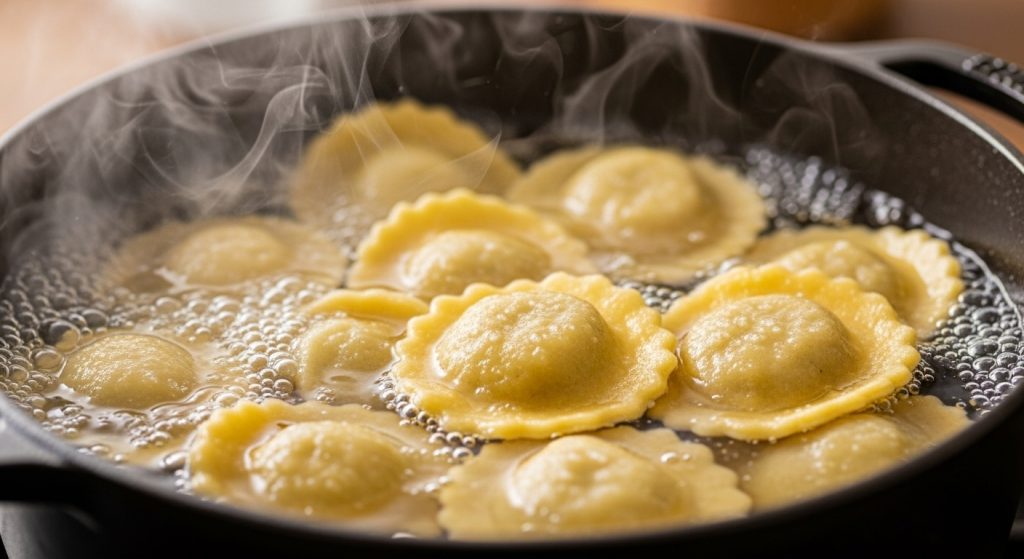
After mastering the assembly techniques for sourdough ravioli, it’s time to contemplate how to elevate your dish with cooking and serving suggestions.
Start by cooking your ravioli in boiling salted water for just 4–6 minutes until they float.
For a classic touch, serve them with marinara or a creamy sauce that complements their tangy flavor. Freshly grated Parmesan or a sprinkle of red pepper flakes can enhance the dish beautifully.
Pair your ravioli with roasted Brussels sprouts or sautéed asparagus to add a delightful crunch. The best side dishes for ravioli include salads and roasted vegetables to create a well-rounded meal. Using high absorbency towels can help keep your kitchen tidy while preparing these delightful sides.
For a complete meal, consider crusty Italian bread and a crisp arugula salad.
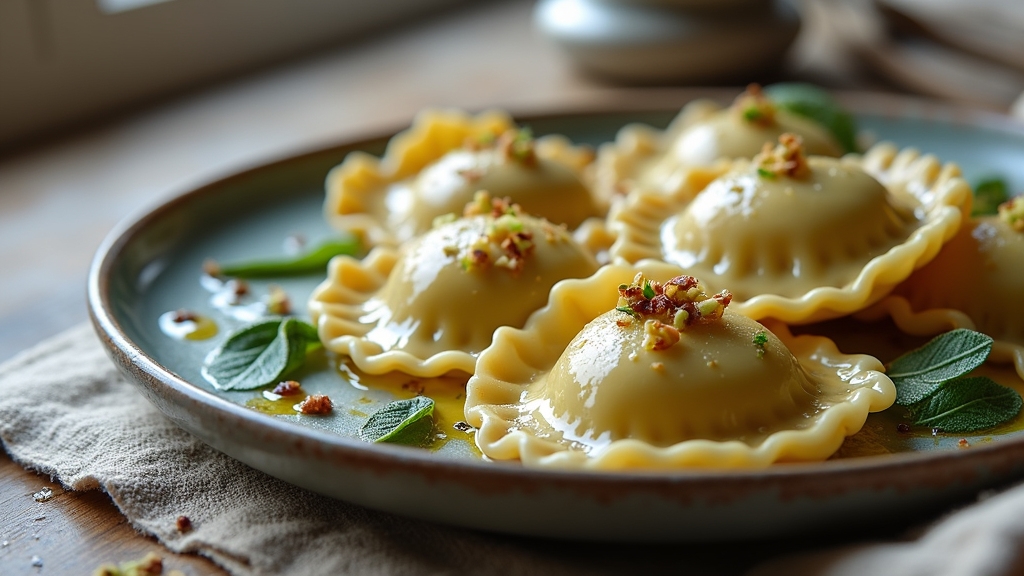
Nutritional and Practical Notes
Understanding the nutritional and practical aspects of sourdough ravioli can enhance your cooking experience and inform your meal choices. Here’s what you need to know:
Average calories per serving can range from 168 to over 600, depending on your fillings.
It’s low in total fat, generally containing around 1g per serving.
Sourdough ravioli offers modest protein (5-8g) and substantial carbohydrates (35-42g). The fermentation process maximizes health benefits and enhances digestibility and nutrient absorption, as it promotes beneficial gut bacteria through prebiotics.
Fresh ravioli should be consumed within 3-5 days or can be frozen for longer storage.
Tips for Perfect Sourdough Ravioli
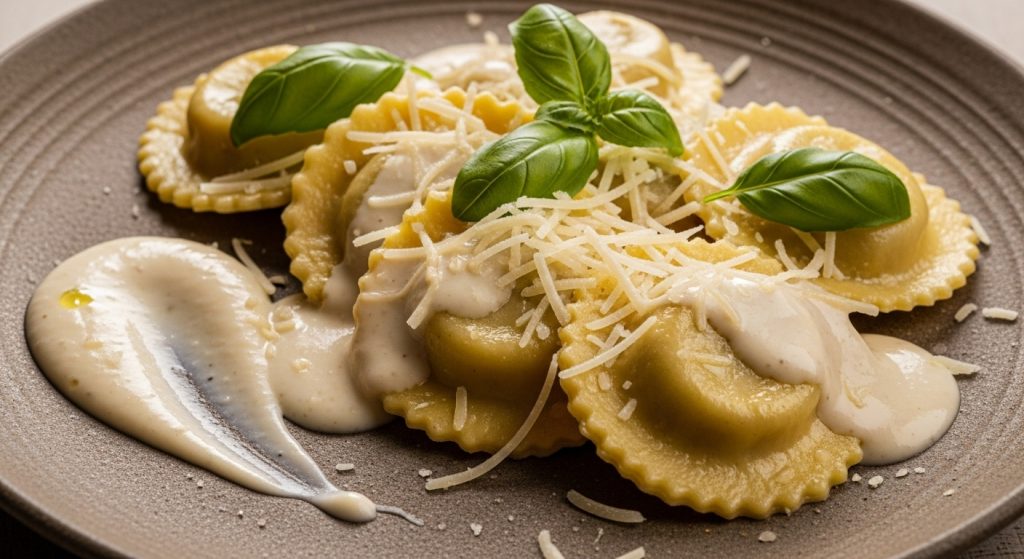
To achieve perfect sourdough ravioli, focus on the dough preparation and handling, as these foundational steps set the stage for delightful results. Knead your dough for about five minutes, letting it absorb any dry flour bits without adding moisture.
After kneading, allow it to rest for at least 30 minutes to relax the gluten. When rolling, divide the dough into manageable portions and aim for a thinness of 1-2 millimeters. Use a damp brush to moisten the edges before sealing, ensuring no air pockets remain.
When cooking, gently transfer ravioli into boiling salted water, and remember to handle them with care. Additionally, ensure to coat uncooked ravioli with semolina or rice flour to prevent sticking, which is crucial for maintaining their shape. These tips will help you craft ravioli that aren’t only delicious but also beautifully shaped.
Frequently Asked Questions
Can I Use Gluten-Free Flour for the Ravioli Dough?
Absolutely, you can use gluten-free flour for ravioli dough! Just remember that since gluten-free flours lack elasticity, you’ll want to mix different types, like sorghum or tapioca, and add binders like xanthan gum.
Adjust the hydration carefully to achieve the right consistency—firm enough to shape yet pliable. Don’t forget to handle the dough gently, as it can be more fragile than traditional pasta.
With patience, you’ll create delicious gluten-free ravioli!
How Long Can I Store Leftover Uncooked Ravioli?
You’ve got about 1 to 2 days to store uncooked ravioli in the fridge before it starts to lose quality and safety. To keep them fresh, use an airtight container and let them air dry first.
If you want to save them longer, freeze those little pasta pockets! They’ll last up to 3 months in the freezer, and you can cook them straight from frozen. Just make sure you avoid any freezer burn!
Can I Freeze Cooked Ravioli for Later Use?
Yes, you can freeze cooked ravioli for later use! Just make sure you cool them completely before freezing to maintain their texture.
Use airtight containers or freezer bags to prevent freezer burn, and remember to label them with the date. For the best quality, aim to enjoy them within two months.
When you’re ready to eat, thaw them overnight in the fridge or boil them directly from frozen for a quick meal!
What Can I Substitute for Ricotta in the Filling?
You can substitute ricotta with several delicious options! Try goat cheese for a tangy kick, or mozzarella for a milder, stretchy texture.
Mascarpone offers creaminess, while Parmesan adds nutty depth. For a vegan twist, blend firm tofu or use store-bought vegan ricotta.
Enhance flavors by incorporating sautéed mushrooms or butternut squash. Just remember to adjust seasoning to balance stronger flavors and drain excess moisture to keep your filling perfect!
How Can I Prevent the Ravioli From Sticking Together?
To prevent your ravioli from sticking together, coat them lightly with semolina or corn flour right after cutting.
Work in small batches to keep the dough moist and cover any unused portions with plastic wrap.
Boil water fully before adding the ravioli, stirring gently to separate them.
After cooking, drain carefully, and you might consider tossing them with a bit of olive oil or sauce to keep them apart and flavorful.
Try New Fillings and Make This Recipe Your Own
You might think making sourdough ravioli is too complicated, but once you immerse yourself, you’ll find it’s a rewarding experience that opens a world of flavors.
Imagine rolling out that silky dough, crafting perfect pockets of your favorite fillings, and savoring each bite of your homemade creation.
With a little practice, you’ll impress your friends and family while enjoying the satisfaction of turning simple ingredients into a gourmet dish.
So grab your rolling pin and let the culinary adventure begin.

